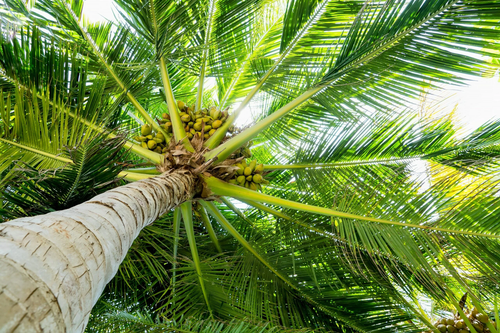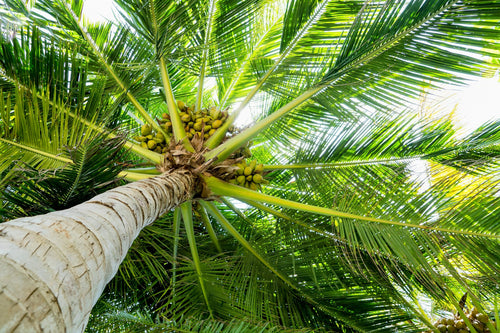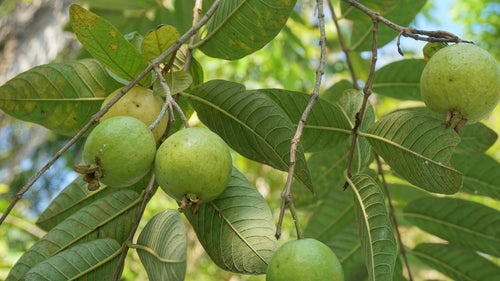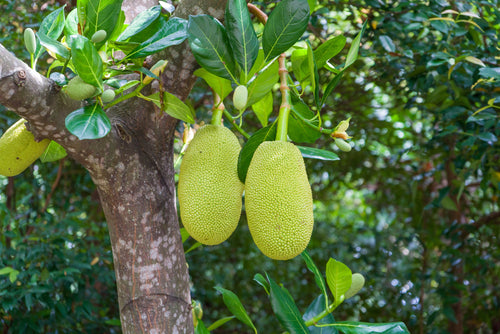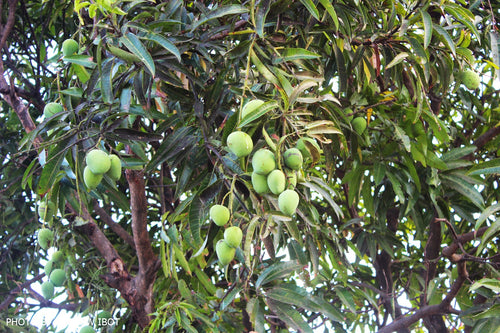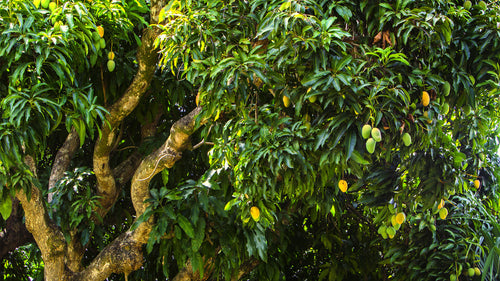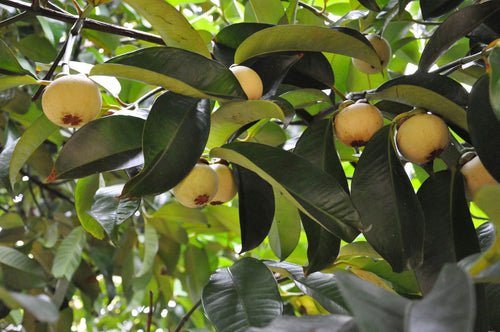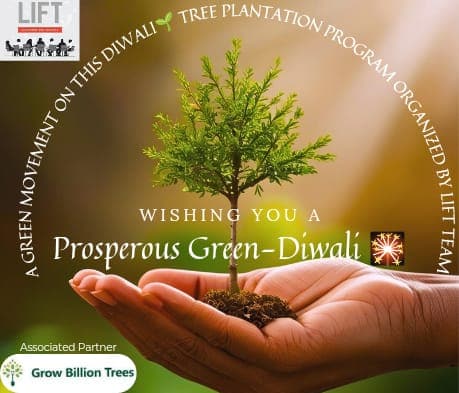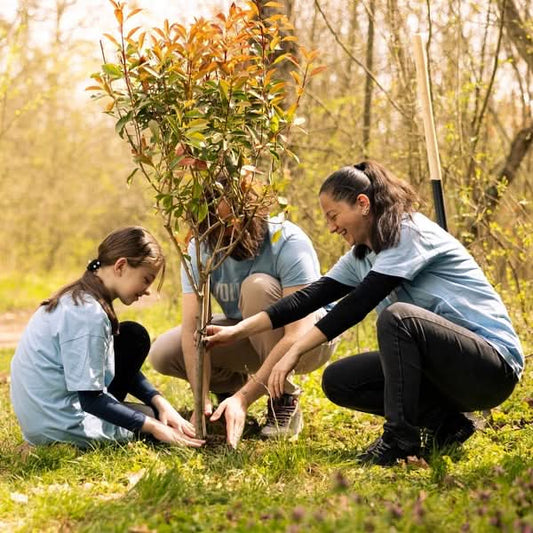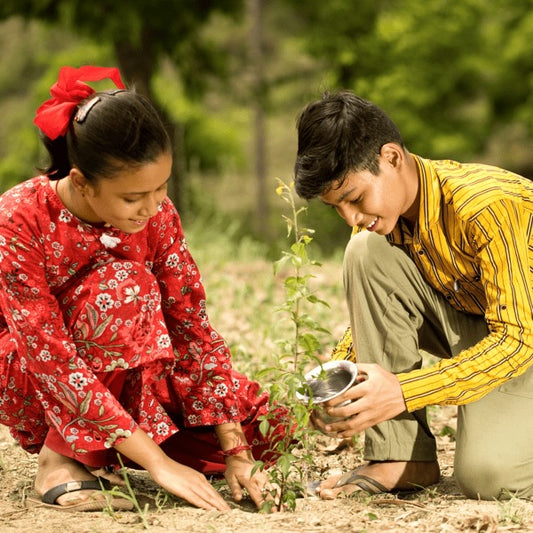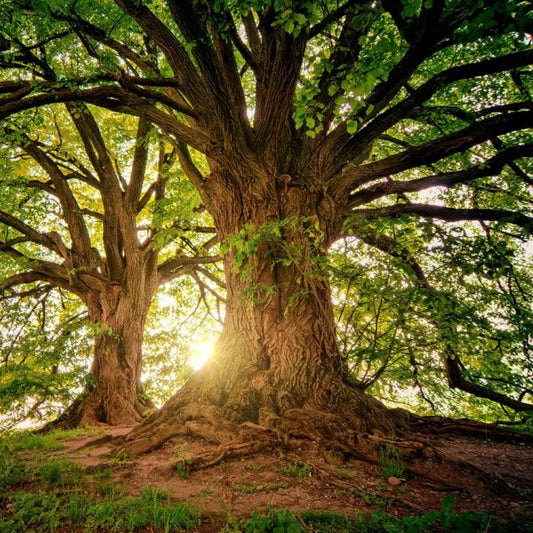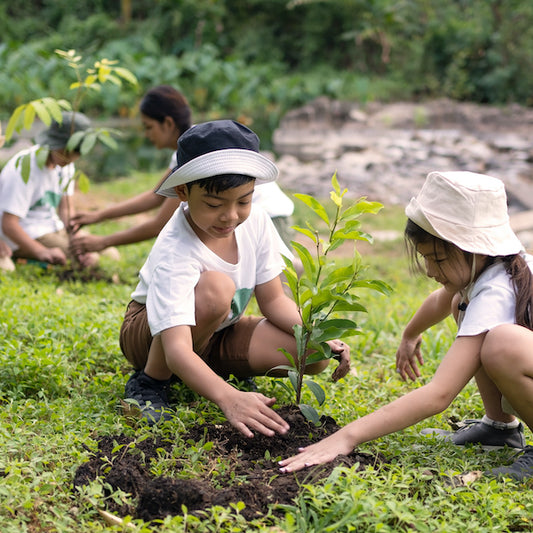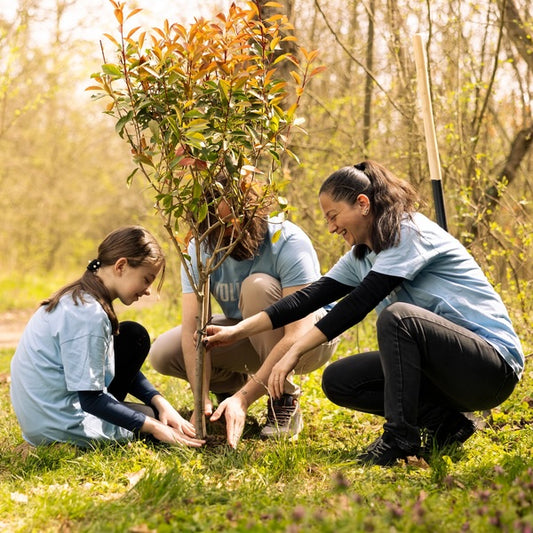Celebrating Growth: Tree Plantation by Rajiv Bajaj for Kalpesh Dave’s Birthday
To commemorate the birthday of Mr. Kalpesh Dave, Deputy CEO of Bajaj Capital, Chairman Mr. Rajiv Bajaj undertook a mean Read more
Project Update 1


Digital Forest
Forest with 14 Trees planned
Want to plant your tree now?
Plant a Tree @ 299Celebrating Growth: Tree Plantation by Rajiv Bajaj for Kalpesh Dave’s Birthday
To commemorate the birthday of Mr. Kalpesh Dave, Deputy CEO of Bajaj Capital, Chairman Mr. Rajiv Bajaj undertook a meaningful tree plantation initiative rooted in the agroforest concept. This thoughtful gesture not only celebrated a special occasion but also reflected Bajaj Capital's commitment to sustainability and environmental stewardship.
In this initiative, trees were planted in an agroforestry manner, ensuring a harmonious integration of agricultural crops and tree species. This approach not only enhances biodiversity but also provides long-term ecological and economic benefits. Farmers collaborated on the plantation activities, symbolizing a community-centric model that supports rural livelihoods while contributing to a greener future.
This act underscores the leadership's vision for a sustainable tomorrow and highlights the company's dedication to environmental causes. The trees planted in honor of Mr. Kalpesh Dave serve as a lasting tribute, growing stronger with time much like Bajaj Capital’s commitment to creating a positive impact on the planet.
Tree Plantation Date
19th April 2024
Plantation Location
Sahayadri Van, Girvi, Satara, Maharashtra 415523
Trees Planted
Total Count: 14 Trees
Species Name: Mango, Guava, Chiku, Jackfruit, Coconut
Forest Type: Agroforest
On the occasion of Deputy CEO Mr. Kalpesh Dave's birthday, Mr. Rajiv Bajaj, Chairman of Bajaj Capital, led a thoughtful tree plantation initiative in the agroforest concept, emphasizing sustainability and community well-being. Agroforestry, which integrates trees with agricultural crops, provides numerous benefits to farmers, including improved soil fertility, enhanced water retention, increased biodiversity, and a sustainable source of income from timber, fruits, or medicinal plants. By involving farmers in this initiative, the effort not only celebrated a special occasion but also empowered rural communities with economic and environmental advantages. This initiative reflects Bajaj Capital’s commitment to fostering a greener planet while supporting livelihoods, creating a legacy of growth and sustainability in honor of Mr. Kalpesh Dave.
Advantages Of Agroforest
Enhanced Income Diversification
Agroforestry allows farmers to generate income from multiple sources, such as timber, fruits, nuts, medicinal plants, and crops, reducing dependence on a single commodity. Trees in agroforests provide year-round products, ensuring a steady cash flow even during off-seasons for crops.
Improved Livelihood Resilience
Agroforests act as buffers against climate shocks like droughts, floods, or erratic rainfall, helping farmers maintain productivity. A diversified system reduces the risk of total loss due to pests, diseases, or market fluctuations affecting one crop type.
Reduced Farming Costs
Trees in agroforestry systems help reduce input costs for farmers. Nitrogen-fixing trees naturally fertilize the soil, cutting down on the need for chemical fertilizers. Certain tree species repel pests or attract beneficial insects, minimizing the use of chemical pesticides. Additionally, leaf litter enriches the soil, lowering expenses on soil amendments.
Environmental Benefits
Agroforests stabilize soil with their roots, preventing erosion and maintaining land productivity. They also improve the microclimate by providing shade and windbreaks, creating a favorable environment for crops and livestock. Furthermore, agroforestry systems sequester atmospheric carbon, contributing to climate change mitigation.
Enhanced Biodiversity
Agroforests support diverse plant and animal species, promoting ecological balance. Trees attract pollinators, which boost crop yields while maintaining biodiversity.
Long-Term Productivity
Agroforestry combines forestry with agriculture, ensuring sustainable land use and preventing land degradation. Trees also enhance groundwater recharge and reduce surface runoff, ensuring better water availability for crops.
Community Empowerment
Agroforestry initiatives create employment opportunities in tree planting, maintenance, and harvesting activities. They also encourage knowledge sharing about sustainable practices, fostering a culture of environmental stewardship.
Activities During Tree Plantation
During the tree plantation initiative led by Mr. Rajiv Bajaj to honor Deputy CEO Mr. Kalpesh Dave’s birthday, all plantation activities were carried out by skilled farmers following the agroforest concept. The process began with site preparation, including soil testing and the creation of planting pits tailored to support tree and crop compatibility. Farmers carefully planted selected diverse tree species known for their ecological and economic benefits, ensuring optimal spacing for harmonious growth alongside crops. They applied organic compost to enrich the soil, mulched the base to retain moisture, and installed irrigation systems to support the saplings. Post-plantation care included initial watering and protective measures to safeguard the young trees from pests or environmental stress, embodying a holistic and sustainable approach to agroforestry.
Tree Plantation Purpose
Sustainable Development Goals (SDGs) Achieved Through Mr. Rajiv Bajaj’s Tree Plantation Initiative in Agroforest Concept
1. SDG 1: No Poverty
The agroforest concept provides farmers with multiple income streams, such as timber, fruits, medicinal plants, and crops, reducing their economic vulnerability. By involving farmers in tree plantation and maintenance, the initiative creates employment opportunities, contributing to poverty alleviation in rural areas.
2. SDG 2: Zero Hunger
Agroforestry enhances food security by improving soil fertility and water retention, leading to higher crop yields. The intercropping of food crops with trees ensures that farmers can produce more nutritious food, benefiting their families and communities.
3. SDG 3: Good Health and Well-Being
Trees in agroforestry systems improve air quality by absorbing carbon dioxide and releasing oxygen, contributing to healthier living environments. Additionally, the biodiversity supported by agroforests provides medicinal plants, which can be used for natural remedies, improving access to traditional healthcare.
4. SDG 6: Clean Water and Sanitation
The initiative helps improve water cycles by enhancing groundwater recharge and reducing surface runoff. Tree roots stabilize soil, preventing water pollution caused by erosion, thus ensuring cleaner water sources for agricultural and domestic use.
5. SDG 8: Decent Work and Economic Growth
The involvement of farmers in tree plantation and maintenance creates rural employment opportunities. The sustainable harvesting of agroforest products promotes economic growth while maintaining ecological balance, ensuring long-term productivity.
6. SDG 12: Responsible Consumption and Production
Agroforestry encourages the use of organic and sustainable farming practices, reducing reliance on chemical fertilizers and pesticides. The diverse outputs from agroforests ensure efficient land use and sustainable production patterns.
7. SDG 13: Climate Action
Trees sequester carbon dioxide, mitigating the effects of climate change. Agroforests also act as climate buffers, reducing the impacts of extreme weather events like floods and droughts, and contributing to global climate resilience.
8. SDG 15: Life on Land
Agroforestry enhances biodiversity by creating habitats for various species of flora and fauna. The initiative promotes sustainable land management, preventing soil degradation and desertification while maintaining ecological balance.
9. SDG 17: Partnerships for the Goals
Mr. Rajiv Bajaj's partnership with Grow Billion Trees exemplifies a collaborative approach to achieving SDG 17: Partnerships for the Goals, fostering impactful environmental and social change. By aligning with Grow Billion Trees, the initiative leverages their expertise in agroforestry and sustainable practices, ensuring the efficient execution of tree plantation activities. This partnership amplifies outreach by engaging farmers, communities, and other stakeholders, creating a ripple effect of awareness and participation. It enables resource sharing, such as knowledge, tools, and manpower, optimizing the plantation process while promoting eco-friendly practices. Together, they demonstrate how synergy between corporate leadership and environmental organizations can drive large-scale efforts toward a greener planet, contributing to global sustainability goals.
ESGs Achieved Through Agroforestry
Environmental (E)
Mr. Rajiv Bajaj’s tree plantation initiative in the agroforest concept significantly contributes to environmental sustainability. By integrating trees with agricultural crops, this initiative enhances biodiversity, promotes soil fertility, and combats soil erosion. The trees sequester carbon dioxide, reducing the impact of climate change and improving the overall ecological balance. Additionally, the initiative boosts groundwater recharge, enhances water retention in the soil, and reduces surface runoff, thereby conserving water resources. The agroforestry approach also supports natural pest control, decreasing reliance on harmful chemical pesticides and fertilizers, leading to healthier ecosystems. Overall, the initiative creates a positive environmental legacy by fostering sustainable land use and mitigating climate-related risks.Social (S)
The social impact of this tree plantation initiative is substantial, particularly in improving the livelihoods of local farmers. By involving farmers in the agroforestry system, the initiative creates new employment opportunities, offering a steady source of income through the sale of timber, fruits, and other tree-based products. The initiative also empowers rural communities by promoting sustainable farming practices, improving food security, and enhancing access to healthcare through the use of medicinal plants. Beyond economic benefits, it fosters community engagement and knowledge sharing, helping farmers adopt eco-friendly techniques that support their well-being and social progress. The initiative creates a sense of shared responsibility towards a greener future, benefiting both the individuals directly involved and the wider society.
Governance (G)
From a governance perspective, Mr. Rajiv Bajaj’s partnership with Grow Billion Trees exemplifies transparency, accountability, and ethical business practices. The initiative adheres to sustainability principles by integrating responsible environmental management with business strategy. It promotes a model of corporate responsibility, where the company’s leadership is actively involved in driving positive environmental and social outcomes. The partnership ensures that the tree plantation efforts are well-managed, with clear guidelines on site preparation, tree selection, and maintenance, ensuring long-term success. By aligning with global sustainability goals, Bajaj Capital demonstrates a commitment to responsible governance, where environmental stewardship and community development are prioritized as part of the company’s core values.
Commitment by Grow Billion Trees
Grow Billion Trees is committed to driving sustainable plantation efforts, ensuring every initiative aligns with key environmental objectives and promotes long-term ecological balance. We focus on selecting native tree species that are well-adapted to local ecosystems, ensuring a higher survival rate and stronger environmental impact.
To maintain plant health and longevity, Grow Billion Trees emphasizes continuous maintenance and regular monitoring of the plantations. This approach helps ensure that each tree thrives, contributing effectively to both biodiversity and climate resilience.
Transparency is a core principle in our operations. Clients receive comprehensive reports, including geo-tagging of planted trees, survival rate updates, and ongoing progress reports. This level of openness allows clients to track the direct impact of their contributions, reinforcing trust and accountability.
Through our dedication to sustainable practices, Grow Billion Trees ensures that every plantation project leaves a lasting positive footprint on both the environment and the local communities it serves.
Summary
Mr. Rajiv Bajaj, Chairman of Bajaj Capital, spearheaded a meaningful tree plantation initiative in the agroforest concept to celebrate the birthday of their Deputy CEO, Mr. Kalpesh Dave. In this initiative, farmers took the lead in planting a variety of tree species, which were carefully selected to complement agricultural crops and promote sustainability. The agroforestry approach aimed at improving soil health, enhancing biodiversity, and supporting sustainable farming practices. By integrating trees with crops, the initiative provided farmers with additional income streams, helping to diversify their livelihoods and improve their resilience to climate-related risks. This initiative also demonstrated a strong commitment to environmental stewardship, reducing carbon emissions and fostering long-term ecological benefits, while empowering the local community and promoting the well-being of both the environment and the people involved. Through this gesture, Mr. Bajaj not only celebrated Mr. Dave's special day but also contributed to a greener and more sustainable future for rural communities.
Trees for Corporates
Trending
Most Popular
Sustainable Tree Planting
Sustainable tree planting is the secret sauce to a greener planet, and it's much more than just adding a sapling to the earth. When done in an agroforestry setting, it ensures trees don’t just survive but thrive alongside crops. The idea is to blend agricultural productivity with environmental protection, allowing farmers to reap both economic and ecological benefits. Think of it as planting a financial hedge against future environmental challenges! Sustainable tree planting benefits soil health, prevents erosion, and helps preserve water resources while offering farmers diversified income. From timber to fruits, and even medicinal plants, these trees don’t just sit pretty—they work hard for their keep! So, whether you're planting a tree for shade or for profit, sustainable tree planting has long-lasting benefits, both for the individual and the planet. After all, who wouldn't want to plant a tree that gives back in more ways than one?
Agroforestry Benefits for Farmers
When farmers add trees to their fields, it’s not just a touch of greenery—they’re investing in a more resilient, profitable, and sustainable farming future. Agroforestry benefits for farmers are like finding a golden ticket, but in the form of diverse income streams. Whether it’s fruit-bearing trees, timber, or medicinal plants, agroforestry provides a variety of products that offer farmers year-round income. Plus, trees protect crops from extreme weather and pests, acting as natural shield bearers. Trees even help in reducing soil erosion and improving water retention, making farming less dependent on unpredictable weather. Essentially, agroforestry turns a single crop field into a multifaceted, eco-friendly powerhouse. So, why not plant a tree and boost your farm’s bottom line? Because nature doesn’t charge interest—she pays dividends!
Climate Change Mitigation through Agroforestry
If you're looking for a win-win solution to fighting climate change, look no further than agroforestry. By planting trees alongside crops, we can sequester carbon, improve soil quality, and enhance biodiversity—all while keeping our agricultural systems profitable. It’s a simple, yet effective, way to tackle climate change. Trees absorb carbon dioxide, helping to combat global warming, while also preventing soil erosion and reducing the need for synthetic fertilizers. The combination of trees and crops also helps increase groundwater recharge, creating a resilient agricultural system. In other words, agroforestry is a carbon-fighting, soil-saving, water-conserving superhero that even farmers can call their own. Climate change may be a massive challenge, but agroforestry provides a grounded solution, one tree at a time.
Agroforestry Systems for Increased Biodiversity
Imagine a farming system where trees, crops, and animals coexist in harmony—welcome to agroforestry! Not only does it help boost agricultural productivity, but it also increases biodiversity. By introducing various tree species into a farm ecosystem, agroforestry creates habitats for birds, insects, and other wildlife. The diversity of plants and animals supports a balanced food chain and contributes to healthier, more resilient ecosystems. Furthermore, trees act as natural pest controllers, attracting beneficial insects and birds that keep harmful pests at bay. It’s a win for the environment, farmers, and biodiversity. So, why settle for a monoculture when you can have an ecosystem full of life? Agroforestry isn’t just good for farmers—it’s great for everyone who loves a vibrant planet.
Soil Health Improvement with Agroforestry
Soil health is the backbone of farming, and agroforestry is like a personal trainer for your soil. The deep-root systems of trees naturally aerate the ground, improving soil structure and helping retain moisture. The organic matter from fallen leaves, bark, and branches enhances soil fertility by adding nutrients over time. Agroforestry also reduces soil erosion by acting as a natural barrier against wind and water. So, if you’re looking to revitalize your soil while boosting crop yields, trees aren’t just decorative—they’re essential. Think of it as giving your soil a nutritious smoothie, with all the benefits it needs to stay strong and fertile. Agroforestry is the ultimate soil spa treatment—one that pays dividends for generations!
Economic Value of Agroforestry Products
Trees in agroforestry systems are more than just pretty faces—they’re money-making machines! Whether it’s timber, fruits, nuts, or medicinal plants, agroforestry offers a range of products that can increase a farmer’s income without the need for additional land. The economic value of agroforestry products is huge—diversifying farm outputs provides financial security and reduces dependence on a single crop. Farmers can harvest timber for construction, fruits for markets, or even sell saplings for replanting. Agroforestry systems also reduce farming costs, thanks to their natural ability to improve soil fertility and water retention. This means farmers save money while simultaneously boosting their income potential. So, let’s be honest—who wouldn’t want an income stream that keeps on giving?
Water Conservation in Agroforestry
In a world where water is becoming an increasingly scarce resource, agroforestry is a game-changer. Trees act as natural water conservers, with their roots improving soil structure and helping it retain moisture longer. This reduces the need for irrigation, saving farmers both water and money. Trees also reduce surface runoff by acting as barriers against rain and wind, ensuring that water is absorbed into the soil rather than lost. In arid regions, where water is precious, agroforestry can create more resilient farming systems, ensuring that crops get the moisture they need to thrive. Agroforestry isn’t just a farming practice—it’s a water-saving revolution. So, let’s plant trees and conserve every precious drop!
Sustainable Land Management with Agroforestry
When it comes to land use, agroforestry is the sustainable solution that keeps on giving. By integrating trees into farming systems, agroforestry promotes the efficient use of land while maintaining its health and fertility. This method prevents overexploitation of the soil, helps manage soil erosion, and allows for better water management. Agroforestry also reduces the need for chemical fertilizers and pesticides, creating a more sustainable and cost-effective farming system. With agroforestry, farmers can make the most of their land while ensuring its productivity for years to come. It's like giving your land a future-proof upgrade—one that keeps it lush and fruitful for generations. Sustainable land management is the backbone of a thriving agricultural system, and agroforestry ensures both.
FAQ
What is agroforestry and how does it benefit individuals?
Agroforestry is the practice of integrating trees and shrubs into agricultural land, creating a sustainable farming system. For individuals, this method enhances income by diversifying agricultural products such as timber, fruits, and nuts. Agroforestry also improves soil health, reduces erosion, conserves water, and promotes biodiversity. By adopting this system, individuals can build resilience against climate change, reduce dependency on single crops, and improve the long-term productivity of their land. It’s a win-win approach that offers both environmental and economic benefits.
How can individuals participate in tree plantation for environmental conservation?
Individuals can contribute to environmental conservation by planting trees in their own gardens, urban spaces, or through community-based initiatives. Participating in local tree plantation drives or adopting agroforestry practices on personal land helps improve air quality, support biodiversity, and combat climate change. Additionally, individuals can support tree-planting organizations or even volunteer to assist in organized plantation events. Small efforts, like planting a tree every year, can create a significant positive impact over time.
What are the benefits of tree plantation for individuals in India?
Tree plantation offers numerous benefits for individuals in India, such as improving air quality, providing shade, and creating green spaces that enhance physical and mental well-being. Trees also help conserve water, reduce soil erosion, and mitigate the effects of climate change by absorbing carbon dioxide. Moreover, planting trees in the right locations can increase property value and provide food and timber resources. Engaging in tree plantation also promotes community involvement, fostering a sense of environmental responsibility.
What types of trees are suitable for agroforestry in India?
In India, a variety of trees are well-suited for agroforestry systems, depending on regional climates and soil conditions. Some commonly chosen species include neem, moringa, teak, sandalwood, and various fruit trees like mango, guava, and papaya. These trees provide environmental benefits like soil improvement, water retention, and carbon sequestration while offering valuable economic returns through timber, fruit, and medicinal products. When selecting trees, it is important to consider their compatibility with local crops and climate to maximize benefits.
How does tree plantation in agroforestry help improve soil health?
In agroforestry, trees contribute to soil health by adding organic matter through fallen leaves, branches, and roots. This organic matter decomposes to enrich the soil with essential nutrients, improving its fertility. Additionally, tree roots help prevent soil erosion and improve water retention, reducing the need for irrigation. Over time, agroforestry practices can restore degraded soil, making it more resilient to weather extremes and increasing the productivity of crops. By adopting agroforestry, individuals can create a sustainable, fertile environment for farming.
What role do individuals play in mitigating climate change through tree plantation?
Individuals can play a crucial role in mitigating climate change by planting trees and supporting reforestation efforts. Trees absorb carbon dioxide, a key greenhouse gas, and release oxygen, contributing to cleaner air. By planting trees, individuals not only help reduce carbon footprints but also create green spaces that combat the urban heat island effect. Engaging in tree plantation activities at home, in communities, or by supporting sustainable land use practices like agroforestry helps in reducing the overall impact of climate change.
How does agroforestry help in water conservation for farmers and individuals?
Agroforestry supports water conservation by improving soil structure and promoting water retention in the land. The deep root systems of trees allow water to be absorbed more efficiently, preventing water runoff and reducing the need for irrigation. For farmers, agroforestry can lower water-related costs and improve crop yields during dry seasons. For individuals, implementing agroforestry on small plots of land or even in urban areas helps conserve water resources and supports sustainable land management, reducing the strain on freshwater supplies.
Can individuals practice agroforestry on small-scale farms or urban areas?
Yes, individuals can definitely practice agroforestry on small-scale farms or even in urban areas. Urban agroforestry allows for the integration of trees in residential gardens, rooftops, or community spaces, improving air quality and biodiversity. On small farms, individuals can plant trees alongside crops to increase yield diversity, improve soil health, and reduce farming costs. The flexibility of agroforestry makes it accessible and beneficial for individuals in various settings, promoting sustainable practices and improving local ecosystems.
What are the economic benefits of tree plantation for individuals in rural areas?
For individuals in rural areas, tree plantation through agroforestry can provide significant economic benefits. Trees offer a diverse range of products such as timber, fruits, nuts, and medicinal plants, creating multiple income streams. By integrating trees into farming systems, individuals can reduce the risk of crop failure due to pests or weather extremes. Additionally, agroforestry improves soil fertility and water retention, boosting crop yields and reducing the need for expensive inputs like fertilizers. It is an effective strategy to enhance livelihoods in rural communities.
How does tree plantation support local biodiversity and wildlife?
Tree plantation supports local biodiversity by creating habitats for various species of animals, birds, insects, and plants. In agroforestry systems, trees contribute to a balanced ecosystem by providing shelter, food, and water for wildlife. The increased variety of plants and trees in the landscape supports pollinators, such as bees and butterflies, which are vital for agricultural productivity. By fostering biodiversity, tree plantation ensures the health of ecosystems and contributes to the conservation of native species, creating a thriving environment for both wildlife and humans.
- Choosing a selection results in a full page refresh.
- Opens in a new window.


